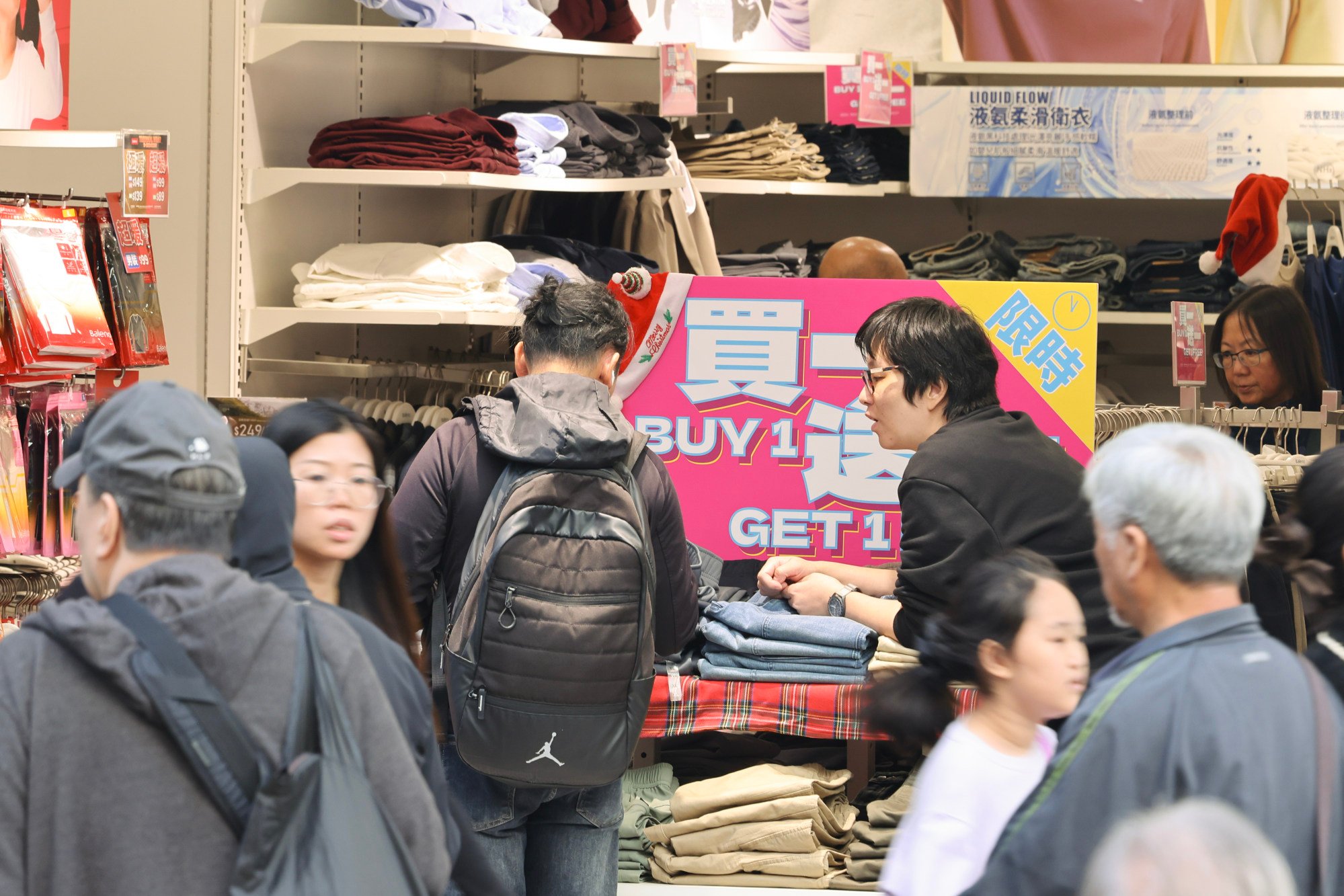For Hong Kong guide dog trainer Margaret To*, an online mothers’ support group has provided a way to cope with rising prices.
Browsing regularly through the Lakesilver Moms chat group, she has found baby clothes, toys, shoes, furniture, home appliances and even a picnic cart. Most were second-hand, some practically new.
“They were all free. This has kept the expenses for our family of three to just under HK$5,000 [US$642] per month,” she said. “In return, I’ve also donated unused items to the group.”
Do you have questions about the biggest topics and trends from around the world? Get the answers with SCMP Knowledge, our new platform of curated content with explainers, FAQs, analyses and infographics brought to you by our award-winning team.
To, 36, and her husband, who works in online marketing, became more careful about spending after their daughter was born 2½ years ago.
For a family stretching a monthly household income of about HK$60,000, every dollar saved mattered. A big chunk – HK$30,000 – went towards the mortgage for their flat in a private housing estate in Wu Kai Sha, northwest of Ma On Shan in the New Territories.
To joined another community group that organises bulk purchases from Japan, to take advantage of the weak yen, saving on cosmetics, food and other items. The group also sourced fruit at lower prices from the Yau Ma Tei fruit market.
“Things in Hong Kong are getting more expensive. We often eat out but restaurant prices have gone up by at least 20 per cent,” she grumbled.
Like To, other residents who have noticed prices creeping up have taken to exchanging second-hand items, organising bulk buys, or heading across the border to eat and shop for a fraction of the price at home.
But while they insist the bite from rising prices is real and painful, their sentiment is not reflected in Hong Kong’s inflation data.
Despite the city’s lacklustre economic performance, it appears to have averted the inflation woes of Japan, the United Kingdom and the United States over the past two years.
Hong Kong’s inflation rate, which peaked at 4.4 per cent in 2022, was just 1.4 per cent in December 2024, unchanged for the third consecutive month and at its lowest since last May.
The composite consumer price index (CPI), which tracks price changes for a basket of goods and services, was a relatively low 1.7 per cent last year.
As an indicator of inflation, the index usually goes up as prices rise.
Yet, it stayed low in December, as prices of alcoholic drinks and tobacco recorded the highest increases of 21.2 per cent, electricity, gas and water prices rose by 11.4 per cent, transport services by 2.1 per cent and eating out and takeaway food went up 1.8 per cent.
Earlier, the city’s taxis raised their flag-fall rate by HK$2 in July, the second fare increase in two years.
So how is it that inflation has stayed low?
Prices have gone up over the years
According to Gary Ng Cheuk-yan, a senior economist at Natixis Corporate and Investment Bank, the answer lies in the basket of goods making up Hong Kong’s CPI and the weightage given to each.
“Despite the fact that electricity and gas prices soared by 11.4 per cent, that wasn’t reflected in the inflation index as they only account for 3 per cent of the overall weighting,” he said.
On the other hand, rent accounted for more than a third of the index but, as levels remained flat, they had a moderating effect on the overall inflation rate.
“That’s why you can’t tell the rising prices of our daily necessities from the inflation rate,” he said. “But when you examine the items one by one, you know that their prices have become more expensive over the years.”
Housing and food prices accounted for a larger share of the CPI in Hong Kong.
Housing stood at about 38.5 per cent, of which rent accounted for 36 per cent. Food, mostly imported from mainland China, accounted for 26.5 per cent.
Other components of the index include electricity, gas and water, which account for 3 per cent of the overall weighting, and transport costs, 7 per cent.

The city’s poor were especially vulnerable to price changes for food and transport, which took up a larger proportion of their spending.
Last October, Hong Kong’s Consumer Council uncovered widespread “shrinkflation” in supermarkets, with shoppers having to pay the same prices for less than before.
Checks showed that the weight or volume of most products had been reduced by as much as 30 per cent but prices remained unchanged, while the prices for 16 items were raised by as much as 26.2 per cent of their recommended price.
Ng said that was why more residents were heading to the mainland or countries such as Japan to shop for cheaper groceries and other goods.
Hongkongers have been flocking to warehouse-style stores on the mainland such as Sam’s Club, bulk-buying everything from tissue paper and snacks to electrical appliances.
The city recorded a 48 per cent year-on-year surge in residents making trips across the border last year, reaching more than 93 million.
‘Even breakfast dim sum costs more’
Tam Yuk-lan, 71, and her husband, both retirees living on a pension, try to keep their monthly household expenses under HK$7,000 and it has become harder to do so.
Their adult son, who works in insurance and lives with them, contributes to the household expenditure too, but Tam said: “Everything is getting more expensive in Hong Kong.”
She was appalled that the price of watercress doubled to HK$6 per catty (600 grams) at the local market near her home in Tuen Mun, and pork ribs cost a fifth more at HK$60 a catty.
“A dim sum breakfast now costs more than HK$65 per person, up from HK$50 in the past,” she said.
Since the border with the mainland reopened two years ago after the Covid-19 pandemic lockdowns, Tam and her husband have been going to Shenzhen about twice a week to buy meat, fish, vegetables, fruit and other necessities.
A dim sum meal there costs no more than HK$30 each.
“We can save HK$2,000 a month by shopping and eating out in Shenzhen,” she said.

Administrative manager Winnie Cheng, 35, has been shopping not only in Shenzhen but also whenever she travels to places such as Japan, South Korea, the UK and Singapore.
She said she always takes an empty suitcase to fill with everything from premium steak to seafood, chicken, organic fruits, vegetables, bread and yogurt.
Visiting Osaka over the Christmas season, she spent HK$750 on a lavish dinner for six which included Japanese Wagyu beef, spider crabs, fatty tuna and uni, or sea urchin, sashimi. She said the same meal in Hong Kong would have cost her HK$4,000.
She tries to travel at least once a month on short trips, mostly over long weekends or by tagging her leave to public holidays.
“If my work schedule allows, I try to travel outside Hong Kong as often as I can to shop for food, shampoo, skincare, make-up and other household products,” Cheng said.
She said each trip could save her “a few thousand dollars” on essential items.
In Shenzhen, she shopped at bulk-buy stores like Sam’s Club, Ole and Walmart, paying bargain prices for high-end items such as Australian rib-eye steak, croissants, US beef tenderloin and crab cakes.
She said: “It’s just a one-hour trip. If you can get 10 croissants in Shenzhen for the price of one in Hong Kong, why not?”
‘Small businesses will be hurt’
Peh Jing Zhi, regional head of goods for online platform Carousell, said more Hongkongers began buying second-hand items to cope with economic challenges, particularly after inflation peaked in 2022.
She said more than four-fifths of consumers who responded to the platform’s 2022 user survey reported that they did more second-hand shopping during that period of economic uncertainty.
The trend had continued, she added, with some “interesting shifts” in the used items Hongkongers were buying.
From 2022 to 2024, categories such as furniture and home accessories, luxury goods, men and women’s fashion, TV sets and home appliances all saw steady single-digit growth in sales.
Sports equipment emerged as a strong growth area with transactions rising by 30 per cent from 2022 to 2023 and another 30 per cent from 2023 to 2024.
Peh said it showed that rising costs in Hong Kong had “not only driven demand for essential items, but also increased interest in lifestyle and hobby-related purchases”.
Aloysius Sng, founder and CEO of Singapore-based Refash, a second-hand clothes chain, said sales had surged after its first outlet opened in Hong Kong last April. It went on to open two more.
The chain sells mainly women’s clothes, though it added menswear when its third outlet opened last year. Its range of dresses, tops, bottoms, activewear, jackets and winter and autumn wear is priced between HK$29 and HK$99.
Dresses and tops are its bestsellers, while winterwear enjoyed a boost in sales during the winter season.
Sng said the Hong Kong outlets were doing better than similar-sized stores in Singapore.
“This growth reflects a trend of increasing demand for quality and affordable sustainable fashion options in Hong Kong,” he said.

Natixis bank economist Ng warned that rising costs would inevitably undermine Hong Kong’s competitiveness.
“It will deal a heavy blow to smaller firms, but we don’t have any solution to counter that,” he said.
“Local firms can’t compete with their mainland counterparts in terms of pricing. They need to find a way to survive such as importing value-for-money goods not easily found in nearby places and strengthening the made-in-Hong Kong brand to cash in on quality.”
He said he expected inflation to rise to 2 per cent this year and that residents would become more conservative in spending.
University of Hong Kong economics lecturer Vera Yuen Wing-han said the city’s small businesses were under threat, as they were losing customers while already struggling with the high costs of manpower and rentals.
She pointed to the growing trend of Hongkongers going shopping online from mainland e-commerce giant Taobao, which offers a wide range of goods at prices 30 per cent to 40 per cent lower than in Hong Kong. The platform is run by Alibaba Group Holding, which owns the South China Morning Post.
“Small firms will have difficulty staying afloat because a lot of mainland firms always offer cheaper goods and services, causing an outflow of patrons,” she said.
But the behaviour of consumers was understandable too. “They need to tighten their belts to counter rising costs,” she said.
*Name changed at interviewee’s request.
More from South China Morning Post:
- Lunar New Year shopping: Hong Kong and Shenzhen battle for dollars and deals
- Cost of living in Hong Kong: what you’ll have to pay more for in 2025
For the latest news from the South China Morning Post download our mobile app. Copyright 2025.





